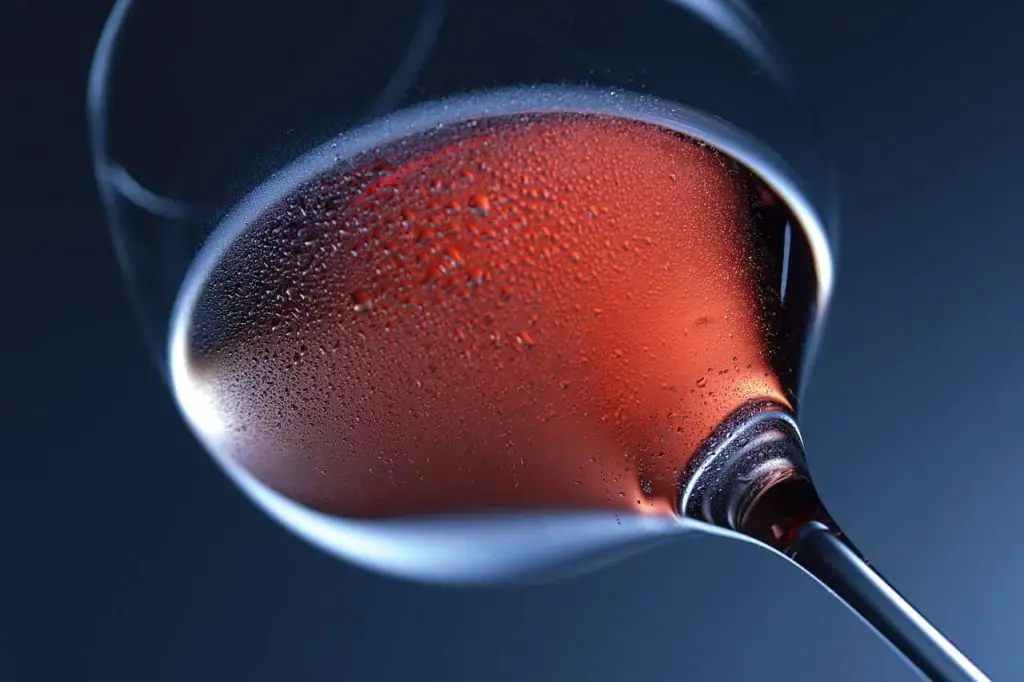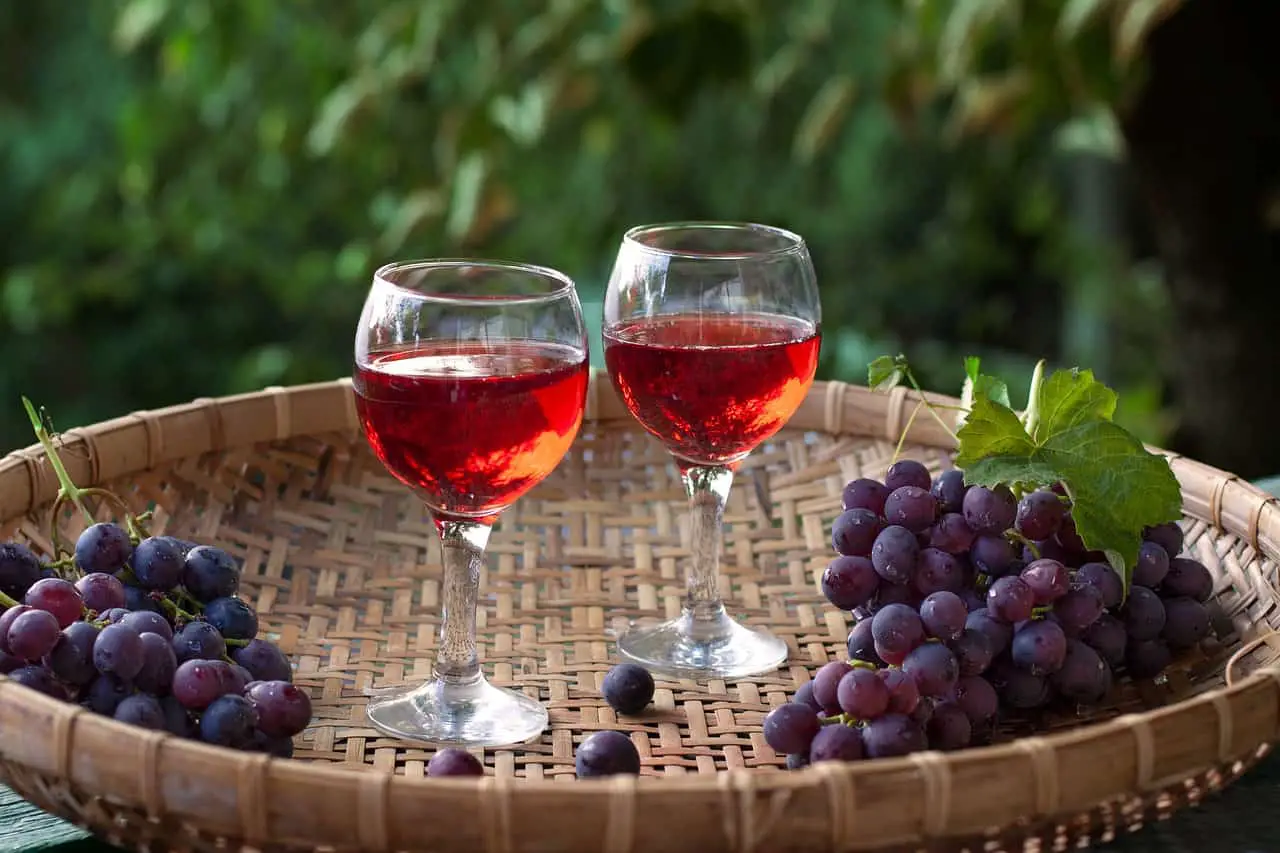Port has been very popular in the UK for centuries. Perhaps you have read novels in which the men retire to another room to drink port, without the ladies. Of course, things have now changed and port is enjoyed by men and women alike.
Port is a complex drink and not all ports are the same. Some have a fruity flavour and aroma while others are nutty. There are two main types of port, Tawny and Ruby, and in this article, we will be taking a look at both of them. This should help you decide which you might prefer.
The Main Differences Between Tawny vs Ruby Port Are?
- Ruby port is sweeter and fruitier than Tawny port. Tawny port is nuttier and often tastes of caramel.
- Tawny port is aged for a long time, while Ruby port is a young wine.
- Ruby port should be served a little chilled, while Tawny port can be served a little colder.
- Tawny port is aged in oak barrels for a long time, while Ruby port is aged for a short time, often in stainless steel vats.
What is Port?

Port is the world’s most popular fortified wine. Fortified wine has another alcohol, often brandy, added to it during the fermentation process. By doing this, the wine becomes sweeter and has a high residual sugar level.
Because these wines are sweet they are often served as a dessert wine or with a cheeseboard. Tawny ports can also be served with main meals as they are less sweet.
Where Does Port Come From?
Port is only allowed to be called by this name if it comes from the Douro Valley in Portugal. The city at the end of the Douro river is called Porto and you will often find this name on a bottle of port. In 1658, the first ships carrying port for England left from Porto and this is still the main port from where this fortified wine is exported. In 1756, the Douro Valley became the first wine appellation in the world.
Terroir
Both the climate and terroir of the Douro Valley is diverse and as a result, different types of grapes are produced, giving a variety of flavours to different ports.
The east of the Diruo Valley is called Cima Corgo. It has a dry climate and some of the best grapes are produced there. Here are created concentrated and long-lasting wines like some of the Tawny ports.
To the west of the valley, you will find Baixo Corgo which has high rainfall. Because of the rain, the yields of grapes are high. These grapes produce light and young ports such as Ruby port.
Douro Superior is at the Spanish border and is hot and dry. From here come the vintage ports.
Although most of the soil in these areas comes from the river banks, the sun exposure, altitude, wind exposure, and access to the water are different. Because of this, the winemakers are able to create different port wines with amazing flavour combinations.
The Grapes

There are around 30 different grapes that are used to make port. Each contributes its own flavour to the port.
Both Tawny and Ruby port are made from red grapes. There is a less common type of port called White port. This is made from white grapes.
This is a selection of the most popular Tawny and Ruby grapes:
- Tinto Cao – This has a velvet texture and crisp acidity.
- Tinto Barroca – These grapes produce a soft and sweet flavour.
- Tinto Roriz – This grape has a resin flavour, similar to Greek retsina. It is very aromatic.
- Touriga Nacional – This tastes of vanilla and blueberry. It is also high in tannins.
- Touriga Franca – This grape is sweet-smelling. It is floral and has flavours of raspberries and cinnamon.
What is the History of Port?
The first shipment of port left Portugal in 1878 for England. At this time, England was stuck in conflicts and wars with France from where they used to get a lot of wine such as Claret and Bordeaux. Because of this, they turned to Portugal. However, the voyage was often rough and to stop the wine from spoiling, brandy was added to the casks. This meant that the wine that reached England was different to normal wine. It was much sweeter, rich and had a high alcohol content. In this way, a new fortified wine called port was created.
How is Port Made?

Port is made in a similar way to wine. The Procedure is as follows;
- Harvest: The grapes mature during the long hot summer and are harvested in the autumn.
- Pressing: The grapes are then pressed. Many vineyards now have mechanical presses, but in some, the grapes are still pressed by foot.
- Fermenting: The grapes are left to ferment for a week. The whole grapes are left to ferment, including the skin and seeds.
- Fortification: This is the process that actually makes port. When the alcohol has reached 7% ABV, brandy or another spirit is added. The spirit stops the fermentation process and both retains the fruit flavours and increases the sugar content. This is why port is often considered to be a dessert wine.
- Aging: Ruby port which is a young wine is just aged for 4 – 8 months in either oak casks or stainless steel vats. Tawny port is aged for much longer in oak casks. You can even purchase a 40-year-old Tawny port. When they are ready, they are put on a ship and go down the Douro River to Porto where they are tasted.
- Combining: Some ports are then combined to give a different array of flavours. They are then bottled for sale.
The main difference between making port and making wine is the addition of brandy during the process.
How to Cook with Port

Tawny port is rarely used for cooking, but Ruby port is a popular addition to many dishes. Ruby ports are cheaper than Tawny ports so you won’t have to worry about adding some to your food. You can add Ruby port to savoury dishes as it will add depth, spices, and a berry flavour to your food. It is often added to sauces and even into chocolate cakes. It can also be reduced down to a glaze and can be an ingredient in a cocktail. Tawny port can also be used in cocktails.
What Does Port Taste Like?
Port is a fortified dessert wine. It is sweeter than normal wine and has 100 grams of sugar per litre. However, the tastes of different ports vary depending on which grapes are used and the length of ageing. Young ports, like Ruby port, taste of spices, and fruits, especially berries. Ruby ports often have an aroma of raspberries and blackberries, as well as chocolate and cinnamon. Older ports, like Tawny port, lose the fruity flavour and instead taste of nuts, caramel, cloves and figs.
Types of Port

As well as Ruby and Tawny port, you can purchase white and rose port, but in this article, we will just be looking at Ruby and Tawny port.
Ruby Port
Ruby port is the youngest of all the ports. It isn’t aged for much longer than 18 months. Because it is so young, it keeps a fruity flavour and is also very reasonably priced.
What Does Ruby Port Taste Like?
Ruby port tastes of cloves, cinnamon, prunes, cherries, raspberries, blackberries, and even chocolate. It is very sweet but is also high in tannins. It is rich, full-bodied, and has a deep red colour.
How is Ruby Port Made?

Ruby port is made in the way we have already described, but it is only aged for up to 18 months. It is generally aged in stainless steel vats so that it doesn’t have an oak taste, unlike Tawny port which is aged in oak casks and has an oak flavour and aroma. The steel vats are large to stop the port from oxidising. This would get rid of a lot of the fruit flavour as well as lose the red ruby colour.
Speciality Ruby Ports
Even though Ruby port is bottled young and is meant to be drunk soon after purchase, there are some special Ruby ports that you don’t have to drink immediately.
- Reserve: This port is blended from the best grapes from different vineyards.
- Late Bottled Reserve: Unusually for a Ruby port, this is aged for between four and six years so has a little less of a fruit taste, with the nutty flavour beginning to emerge.
- Crusted: This is a blend from more than one harvest, but is aged for a short period. Unlike most Ruby ports, it does contain sediment so needs to be decanted.
- Vintage: This Ruby port is aged for six months in an oak cask, but it is not bottled and sold there and then. Instead, it is bottled and aged for 20 years.
- Single Quinta: This is a Vintage Ruby port that comes from only one vineyard.
The last three are aged in oak for a maximum of two years, are bottled, and aged for longer. The extra ageing brings out the flavours of the different grapes.
What Food Pairs with Ruby Port?

You can use Ruby port to add flavours and richness to sauces. It can be added to cakes and desserts to give them a little kick. However, it can also be served with certain dishes. It is a nice accompaniment to a fruit dessert, particularly one with berries, and a cheeseboard. Aged cheeses and blue cheeses taste particularly good when paired with a Ruby port. If you are having steak in a fruit sauce, Ruby port makes a good accompaniment. You can also reduce Ruby port down to make a glaze for a goose. If you feel full after a meal, why not have a glass of Ruby port as your dessert. It will give you the sugar rush you need. Ruby port can be served with chocolate truffles at the end of a meal and can be added to chocolate sauces.
How to Serve Ruby Port
Put the port in the fridge to chill and then take it out 30 minutes before serving so that it can warm up a little. It should be served at about 15C. You don’t need to decant Ruby port, apart from the Crusted version. You can also make cocktails out of it, for example, a Porto which is a mixture of Ruby port and brandy or a Porto Rico which mixes port, scotch, and lemon juice.
The Best Ruby Ports
There are so many different Ruby Ports out there so you will be spoilt for choice. We will give you a few of our favourites:
Niepoort Ruby Port

This port has an aroma of raisins, maple syrup, and brown sugar. It tastes like blackberries, raspberries, plums, blackcurrants, and cherries. There is a faint taste of sourness from the tannins in the port, but this is good otherwise it would be too sweet. It is high in alcohol and has 20% ABV.
Sandeman Founders Reserve Porto
This Ruby port smells of blackberry and plum jam and the taste is fruity, with a hint of chocolate. It is a lighter port as it doesn’t have too many tannins.There is a faint aroma of oak and it is a ruby red colour.
Graham’s Late Bottled Vintage 2012
This is a very special Ruby port and is the finest port to be produced in 2012. It is a little different from many Ruby ports as it is matured in oak casks for four years before being bottled. It smells of figs, prunes, tobacco, and caramel fruitcake, and tastes of mint, dark chocolate, cherries, and blackberries. It can be drunk on purchase or you can leave it for a few years in the cellar.
The best producers of Ruby port include Warre’s, Taylor Fladgate, Niepoort, Six Grapes, Graham’s, Croft, Sandeman, and Cockburns.
Tawny Port
Tawny port may be made with the same grapes as Ruby port, but it is different in many ways. It is aged in oak casks for up to 40 years, has a nutty flavour rather than fruit, and is a rich mahogany colour compared to the red colour of Ruby port.
What Does Tawny Port Taste Like?

Tawny port is more complex than Ruby port and has more flavours. It is nutty and often tastes of caramel. In a younger Tawny port you might get the taste and smell of cinnamon. You should also taste cloves, white pepper, toffee, fig, dried raisins, oak, and dried apricots. There are few signs of fruit due to the longer ageing process, apart from a little raspberry and cherry. In older Tawny ports, you might taste butterscotch and vanilla.
How is Tawny Port Made?
Tawny port is made in the way we have described, but it is different from Ruby port as it is aged for much longer. It is aged in small oak barrels which let in more oxygen. This slow oxygenation means that the port will last for a longer time than Ruby port and that it will lose the red colour and instead be a deep mahogany.
A run-of-the-mill bottle of Tawny port, which is the most affordable, is aged for just three years. However, many Tawny ports are aged for much longer. They can be aged for 40 years or even longer. The longer a Tawny port ages for, the less fruity it becomes and instead takes on a caramel and nut flavours and aromas.
Aged and Other Speciality Tawny Ports

As with Ruby port, Tawny port can include grapes from different vineyards and in addition, the port can be combined with another one to make a unique port. Some ports will have a year mark on them and all the grapes included in that port are no younger than the number on the bottle. Here we have the main speciality Tawny ports –
- Calheita; The grapes in this specialty port are harvested in the same year.
- Tawny 10; This port has been aged for a minimum of 10 years. It tastes of cinnamon and raspberry.
- Tawny 20: The port has been aged for 20 years. The fruitiness has gone and now there is a flavour of cinnamon and caramel.
- Tawny 30: The port has been aged for 30 years and now it tastes of nuts and caramel. It is also much smoother than a Ruby port.
- Tawny 40: The port has been aged for 40 years. It is even smoother and tastes of nuts, vanilla, and butterscotch.
Aging a port for many years helps to get rid of the tannins and this makes the port smoother, as well as mellow.
What Foods Pair with Tawny Port?
You can pair Tawny port with some desserts, but because it has such a nutty taste, it goes well with savoury foods. It goes well with a cheeseboard, especially soft cheese and cheddar. It is a good accompaniment to nuts and some fruits such as apples and bananas which aren’t overly sweet. Duck liver pate and foie gras goes well with it and you could try it out with other pates, even vegetarian ones. If you do want to serve it with a dessert the best choices are apple pie, coconut cream pie, Biscotti, pecan pie, caramel cheesecake, and creme brulee. If you just want to have the port with chocolates, milk chocolate is best.
How to Serve Tawny Port

Tawny ports are best served at temperatures between 10C and 14C, a little colder than Ruby ports. You can keep it in the fridge, but take it out 15 minutes before you intend to serve it. This will take the chill off and let the flavours emerge. You don’t need to decant Tawny ports which are aged up to 30 years as there won’t be any sediment. However, you will need to decant a Tawny port that has been aged for longer.
You can use Tawny port in cocktails, for example a Bitter Harbour, which has port, Mezcal, and bitters in it. It can also be used in a punch. Trafalgar Punch consists of Tawny port, Armagnac, rum, mineral water, lemon juice, sugar, and nutmeg.
The Best Tawny Ports
There are a lot of companies out there that produce Tawny port and it can be difficult to know what to choose. We have picked a few of our favourites which hopefully you will also like.
Quinta Do Infantado
This is a port that has been aged for 10 years so it is fairly young in Tawny terms. It has aromas and tastes of toasted orange peel, coffee grinds, caramel, and toffee. It is silky and smooth and very easy to drink. If you drink it slowly, you may taste oak and raisins. At 20% ABV it is high in alcohol. It is also low in tannins which is good for those with sensitive stomachs.
Taylor Fladgate 20-Year Old Tawny Port
This port is excellent served chilled on a warm summer’s day due to its floral aroma. It is smooth and tastes of fig, apricot, candied ginger, toasted walnuts, and a touch of mango. There are aromas of tropical fruit, honey and butterscotch. It is only mildly sweet so would pair well with a dessert as well as a cheeseboard.
Dow’s 40-Year Old Tawny Port
This is one of the oldest ports out there. You get a taste of wood and nuts, as well as caramel. It will go well with a dessert such as flan or creme brulee. There are aromas of almonds, raisins, toffee, and fig. In addition, there are notes of toasted bergamot, green tea, and honey. It is a complex port with layer upon layer of different flavours and aromas.

Frequently Asked Questions
Is there a rose version or port wine?
About 10 years ago, winemakers experimented with a new type of port. They fermented it in a similar way to which rose wine is produced. As a result a rose port was developed. It is not as easy to find as Ruby and Tawny port, but it is becoming more popular.
What can you mix with Ruby port
You can make a great variety of cocktails with Ruby port, for example, a New York Collins which has Ruby port, American rye whiskey, lemon juice, and simple syrup.
How do you store port?
Like wine, port is best kept in a cool, dark place. Older Tawny ports need to be stored on their sides, while younger Tawny ports and Ruby ports can be stored upright.
What does “Do you know the Bishop of Norwich” mean?
This expression goes back to the 18th and 19th centuries. At a dinner party at that time, it was common to drink port at the end of a meal. It was passed around the table to the left. If somebody doesn’t do this and holds on to the decanter, it was common to ask that person if he or she knew the Bishop of Norwich. If that person said he or she didn’t know the bishop of Norwich, the answer would be “He’s a lovely man, but he always forgot to pass the port”. That should have spurred the person holding on to the port to pass it along.
How long does port last when it is unopened?
If stored in the correct way, i.e., in a dark cool place, port will last for many years. Ruby port doesn’t improve with age, so there is little point keeping it for a long time. On the other hand, Tawny port gets better with age so keep it for as long as you want in the right atmosphere.
How long does port last when opened?
Once opened, you will need to store the port in the fridge. Ruby ports last for about a fortnight, while Tawny ports last for a month. Tawny ports last for longer as they are oxidised in their casks. If you have a cool cellar, keep your opened port there.
There is just one exception to this rule. Vintage port should be drunk within 24 hours.
How much is one serving of port?
A serving of port is 3 ounces or 85 mls.
Do you have to decant port?
Ruby ports don’t need to be decanted, nor do Tawny ports, except for Vintage Tawny ports. Because they are in their casks for a long time, sediment is produced. Crusted ports should also be decanted. Do this two hours before serving.
How do you serve port?
Ruby ports can be served straight from the bottle at approximately 15C, while Tawny ports can be chilled more and served at 10 – 14C.. Vintage ports should be decanted and then served at 15C.
Both types of port can be used in cocktails even though it is more common to serve them on their own.
What glass do I serve port in?
Port isn’t meant to be served in a red wine glass, but in something smaller. These glasses hold 7 ounces of port or 200 mls. They are about 15 centimetres tall.

